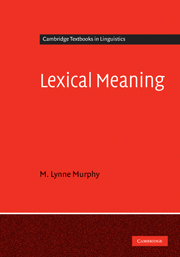Book contents
- Frontmatter
- Contents
- List of figures
- Preface: using this book
- Acknowledgments
- Typographical conventions
- Part I Meaning and the lexicon
- 1 The lexicon – some preliminaries
- 2 What do we mean by meaning?
- 3 Components and prototypes
- 4 Modern componential approaches – and some alternatives
- Part II Relations among words and senses
- Part III Word classes and semantic types
- References
- Index
2 - What do we mean by meaning?
from Part I - Meaning and the lexicon
Published online by Cambridge University Press: 05 June 2012
- Frontmatter
- Contents
- List of figures
- Preface: using this book
- Acknowledgments
- Typographical conventions
- Part I Meaning and the lexicon
- 1 The lexicon – some preliminaries
- 2 What do we mean by meaning?
- 3 Components and prototypes
- 4 Modern componential approaches – and some alternatives
- Part II Relations among words and senses
- Part III Word classes and semantic types
- References
- Index
Summary
Key words:
pragmatics, inference, entailment, denotation, connotation, social meaning, affect, sense, reference, referential theory, extension, image theory
Overview
While the last chapter defined the lexical in lexical meaning, in this chapter we start to consider the meaning of meaning. While the term meaning is used in many ways inside and outside the discipline of linguistics, the semantic approach in this book is particularly concerned with denotative meaning. The next section compares denotative meaning to other meaning types and looks at the questions lexical semanticists ask and why they ask them. After that, we look at how to define denotative meaning, focusing on defining the difference between what a word refers to and what a word “means.”
- Type
- Chapter
- Information
- Lexical Meaning , pp. 29 - 42Publisher: Cambridge University PressPrint publication year: 2010

